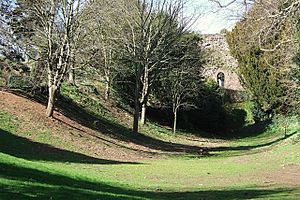Rougemont Gardens facts for kids
Rougemont Gardens is a beautiful park next to Rougemont Castle in the city of Exeter, Devon, England. It's a special place, listed as a Grade II historic park. This means it's important for its history and design. The gardens were once part of the castle's defenses. In the late 1700s, they became a lovely garden. The city council bought them in 1912, so everyone could enjoy them.
Where are Rougemont Gardens?
The gardens have clear boundaries. To the northwest, you'll find the old city wall with Northernhay Gardens just beyond it. To the northeast, the castle wall stands tall, meeting Athelstan's Tower. The eastern side is Castle Street, with the old Norman gatehouse at the top and Rougemont House below. On the south, the Exeter City Central Library forms the edge. To the southeast, you'll see the Phoenix Arts Centre and the Royal Albert Memorial Museum.
A Look Back: History of the Gardens
The area where Rougemont Gardens sits was once a key part of William the Conqueror's defenses. He built Rougemont Castle in 1068 during the Norman Conquest. The castle included a defensive ditch, which is why the gardens have their unique shape today. Some people think this ditch might have been a Roman quarry. The Romans might have dug out stone here to build the original city walls.

Around 1768, a local surgeon named John Patch built Rougemont House. This house was just below the old Norman gatehouse. He also created gardens behind his new home. Over the years, different owners made changes to the house and gardens. By the Victorian times, people called the garden "a perfect sylvan retreat." This means it was a peaceful, forest-like escape.
Exeter City Council bought Rougemont House in 1911. They bought the garden grounds the next year. For many years in the 20th century, Rougemont House was a museum. It was open to the public, but it has since closed.
Today, the entire gardens, including the castle and city walls, Athelstan's Tower, and the gatehouse, are protected. They are a nationally important archaeological site. The city council takes care of them as a public park. Until 2009, the Northcott Theatre used the gardens for summer plays. The old city wall and defensive ditch made a natural stage for their performances.
Images for kids




